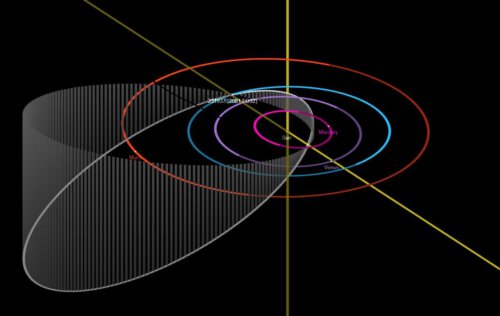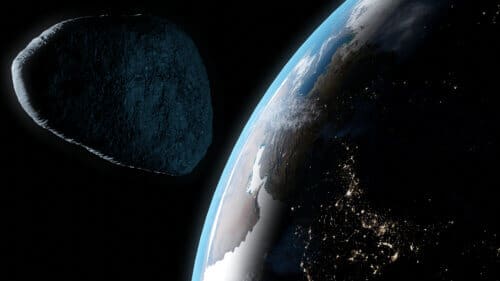However, no danger is expected from this asteroid - on March 6, astronomers and astronomy enthusiasts watched the transit of the asteroid Apophis, which will return much closer to us in 2029
NASA announced last Thursday (March 11, 2021) that an asteroid named 2001 FO32 will pass near Earth on March 21, but it will not come closer than 2.2 million km. The space agency emphasizes that there is absolutely no threat of a collision with our planet now or for hundreds of years to come." It was written in a message from NASA.

"We know FO32 2001's orbit around the Sun very precisely, and have been following it since it was discovered 20 years ago. Paul Chodas, director of the Center for Near-Earth Object Studies (CNEOS), run by JPL, said in the same announcement.
The asteroid, whose width is estimated to be about 440 to 680 meters wide, will approach us at an enormous speed of 124,000 km/h, faster than most asteroids that pass by the Earth. Its extraordinary speed is due to its elongated and highly inclined orbit around the Sun, as the rock approaches the inner solar system, it picks up speed before heading back towards deep space. Its orbit lasts 810 days.
The rock is considered by CNEOS to be a "Potentially Hazardous Asteroid", or PHA. The CNEOS tracks PHA objects like 2001 FO32 using ground-based radars and telescopes, tracking their movement in case they get close enough to Earth to pose a risk of impact.
The (relatively) close passage of Apophis

A 340-meter-wide space rock named Apophis passed safely past Earth on March 6. The next time it returns, in 2029, it will come within 40 km of Earth and pass near the orbit of the communication satellites. This will be the first time astronomers will be able to observe such a large asteroid passing so close to us.
Last week's transit gave scientists a chance to test the global planetary defense system, which astronomers use to quickly assess the chance of an asteroid hitting Earth. "It's a fire drill with a real asteroid," says Vishnu Reddy, a planetary scientist at the University of Arizona in Tucson, who coordinated the observation project.
Apophis' transit highlights how much astronomers have learned about near-Earth asteroids—and how much they still have to learn. Since 1998, when NASA began the largest search for near-Earth asteroids, scientists have discovered more than 25,000 of them. And the year 2020 turned out to be a record year in discoveries. Despite the COVID-19 epidemic that disrupted many of the observations, astronomers cataloged during the year 2,958 asteroids that were unknown to us.
A record year in the discovery of near-Earth objects since observations began in 1995
The largest number of asteroids was discovered by the Catalina Autonomous Sky Survey, which uses three telescopes in Arizona to look for threatening space rocks. Project operations were briefly shut down last spring due to the pandemic, and a fire caused a longer shutdown in June, yet the Catalina survey still discovered 1,548 new near-Earth objects. Among them is a rare "tiny moon" called 2020 CD3, an asteroid less than 3 meters in diameter that was temporarily captured by Earth's gravity. The tiny moon broke away from Earth's pull last April.
Another set of discoveries last year – 1,152 – came from the Pan-STARRS survey telescopes in Hawaii. The findings included an object called 2020 SO, which turned out not to be an asteroid, but a leftover rocket stage that has remained in space since it helped launch a NASA mission to the moon in 1966.
Some of the asteroids discovered last year came very close to Earth. At least 107 of them passed by the Earth at a distance smaller than that of the Moon. 2020's close pass included the tiny asteroid 2020 QG, which passed just 2,950 kilometers above the Indian Ocean in August. This made it the closest known transit, a record broken just three months later by another small object, 2020 VT4. This object passed less than 400 kilometers above us and was not observed until only 15 hours after it passed by us. However if it had hit, it would probably have disintegrated in the Earth's atmosphere.
All these discoveries make astronomers more aware of the billiard ball nature of the solar system. Many asteroids orbit in space near Earth. The success of the Apophis observations underscores how astronomers around the world can work together to assess the threat posed by asteroids, Reddy says. "It was a huge international effort and a lot of fun." By the time Apophis arrives again, in eight years, scientists will take an even more detailed census of threatening space rocks.
More of the topic in Hayadan:
- The never-ending story of Apophis - third and final part
- The never-ending story of Apophis - part two
- Russia has plans to launch spacecraft to Mars, Venus and the asteroid Apophis
- Britain plans to launch a spacecraft to approach asteroid Apophis
- Russia wants to build a missile that will destroy asteroids that threaten Earth

One response
Stunning